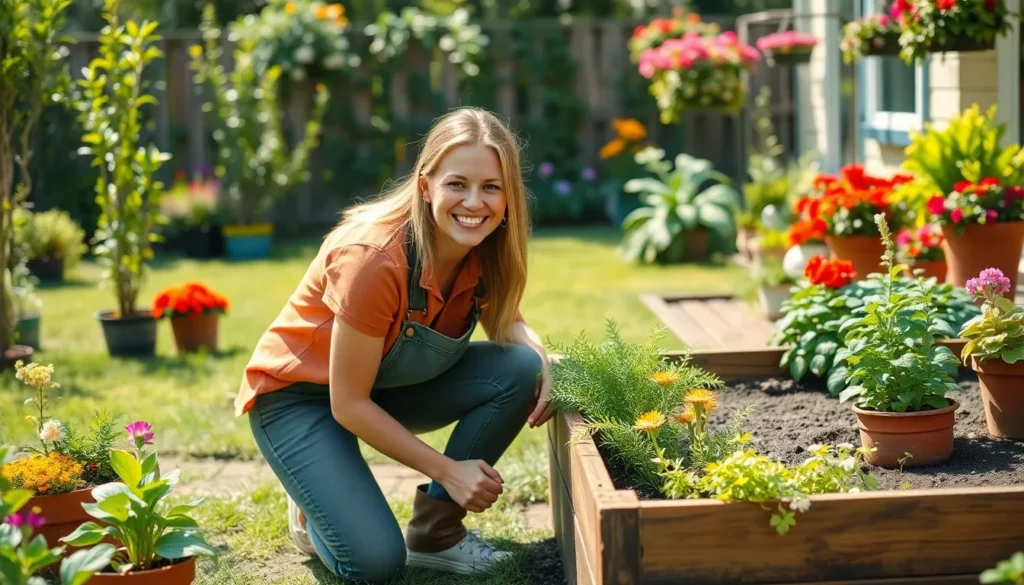We’ve all stared at our outdoor spaces wondering how to transform them into beautiful gardens without breaking our backs or budgets. Whether you’re dealing with a small balcony or a sprawling backyard, creating an amazing garden doesn’t require years of experience or expensive equipment.
Simple gardening answers can turn even the most challenging spaces into thriving green sanctuaries. From container gardens that work perfectly for beginners to low-maintenance plants that practically grow themselves, we’ll show you how to achieve stunning results with minimal effort.
The best part? These easy garden ideas work for every skill level and space constraint. We’re talking about practical approaches that deliver maximum impact while fitting into your busy lifestyle. Ready to discover how simple tweaks can create the garden you’ve always wanted?
Start With Simple Container Gardens for Instant Results
Container gardening offers the perfect solution for transforming any space into a lush green oasis within just a few weeks. We can create stunning garden displays without digging up our yards or committing to permanent landscaping changes.
Choose the Right Containers for Your Space
Size matters when selecting containers for our garden projects. We recommend choosing pots that are at least 12 inches deep for most vegetables and herbs, while flowers can thrive in containers as shallow as 6 inches. Large containers like whiskey barrels, ceramic planters, or wooden boxes hold moisture longer and provide more root space for plants to flourish.
Drainage becomes crucial for healthy plant growth in any container setup. We should ensure every pot has holes in the bottom to prevent water from pooling and causing root rot. Adding a layer of gravel or broken pottery pieces at the bottom creates better drainage and keeps soil from washing away.
Material selection affects both plant health and maintenance requirements. Plastic containers retain moisture longer and cost less, making them ideal for beginners who might forget to water regularly. Terra cotta pots provide excellent drainage and prevent overwatering, though they require more frequent watering in hot climates.
Placement considerations help maximize our container garden’s success. We can position lightweight containers on wheels or plant caddies to move them easily as seasons change or to follow sunlight patterns throughout the day.
Select Low-Maintenance Plants for Beginners
Herbs provide the easiest starting point for new container gardeners. We suggest beginning with basil, mint, oregano, and thyme since they grow quickly, tolerate various watering schedules, and offer immediate culinary rewards. These plants typically reach harvest size within 4 to 6 weeks of planting.
Succulents require minimal care while delivering maximum visual impact. We can choose varieties like jade plants, echeveria, or sedum that need watering only once every 1 to 2 weeks and thrive in both indoor and outdoor settings.
Annual flowers create colorful displays with simple maintenance routines. Marigolds, zinnias, and petunias bloom continuously from spring through fall with basic watering and occasional deadheading of spent flowers.
Vegetable options for beginners include fast growing crops that forgive mistakes. We recommend lettuce, radishes, cherry tomatoes, and peppers since they adapt well to container life and produce harvests within 30 to 90 days depending on the variety.
Native plants adapted to our local climate reduce watering and fertilizing needs significantly. We should visit local nurseries to identify which plants naturally thrive in our exact region’s weather patterns and soil conditions.
Create a Basic Herb Garden in Any Small Space
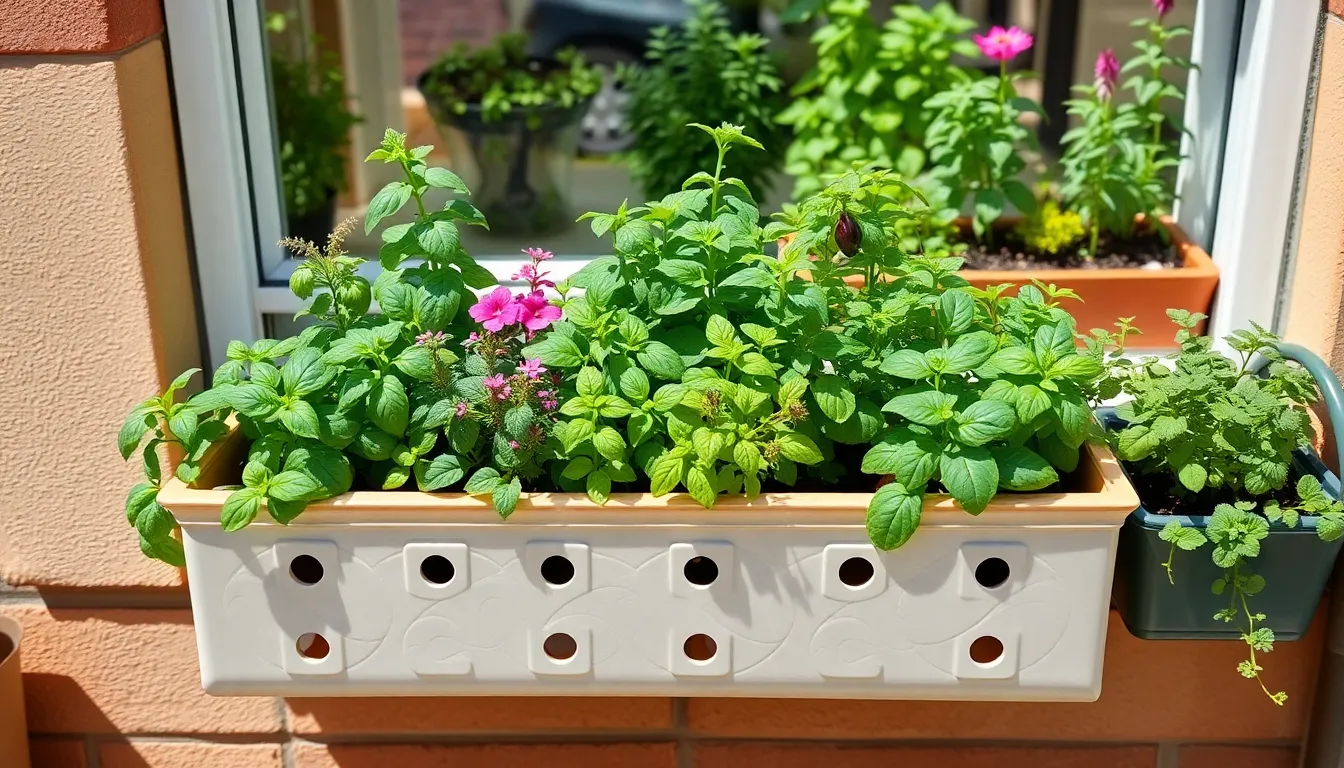
Starting an herb garden requires minimal space and provides maximum satisfaction for both novice and experienced gardeners. Cedar, steel, or terra cotta containers work perfectly as herb planters, though you’ll need to ensure they include drainage holes to prevent overwatering.
Pick Fast-Growing Herbs Like Basil and Mint
Basil stands out as our top recommendation for small space herb gardens because it grows quickly and works perfectly in Italian dishes. We’ve found that this aromatic herb thrives in containers and provides continuous harvests throughout the growing season.
Mint offers another excellent choice for rapid growth, making it ideal for gardeners who want immediate results. This versatile herb spreads quickly and adds fresh flavor to teas, desserts, and savory dishes.
Thyme brings Mediterranean flavors to your container garden while requiring minimal maintenance and space. Cilantro rounds out our essential herbs list, growing fast and providing fresh leaves for Mexican and Asian cuisine.
These four herbs create a diverse flavor palette while remaining easy to grow for beginners in any small gardening space.
Use Window Boxes or Small Raised Beds
Window boxes maximize growing space on balconies and windowsills, providing enough room for several herb plants in compact areas. We recommend choosing boxes that match your container material preferences while ensuring adequate drainage.
Small raised beds work perfectly for patios and small backyards, allowing you to grow multiple herbs alongside companion plants like violas. These elevated growing spaces improve drainage and make harvesting easier for gardeners with limited mobility.
Vertical gardening answers include trellis systems and rail planters that transform walls and railings into productive growing spaces. This approach helps you maximize every square inch of available area while creating an attractive green display.
| Growing Method | Best Location | Plant Capacity | Drainage Requirements |
|---|---|---|---|
| Window Boxes | Balconies, Windowsills | 3-5 herbs | Essential drainage holes |
| Small Raised Beds | Patios, Small Yards | 6-10 herbs + companions | Built-in drainage layer |
| Vertical Systems | Walls, Railings | 8-12 herbs | Individual container drainage |
Design Easy Flower Beds With Perennial Plants
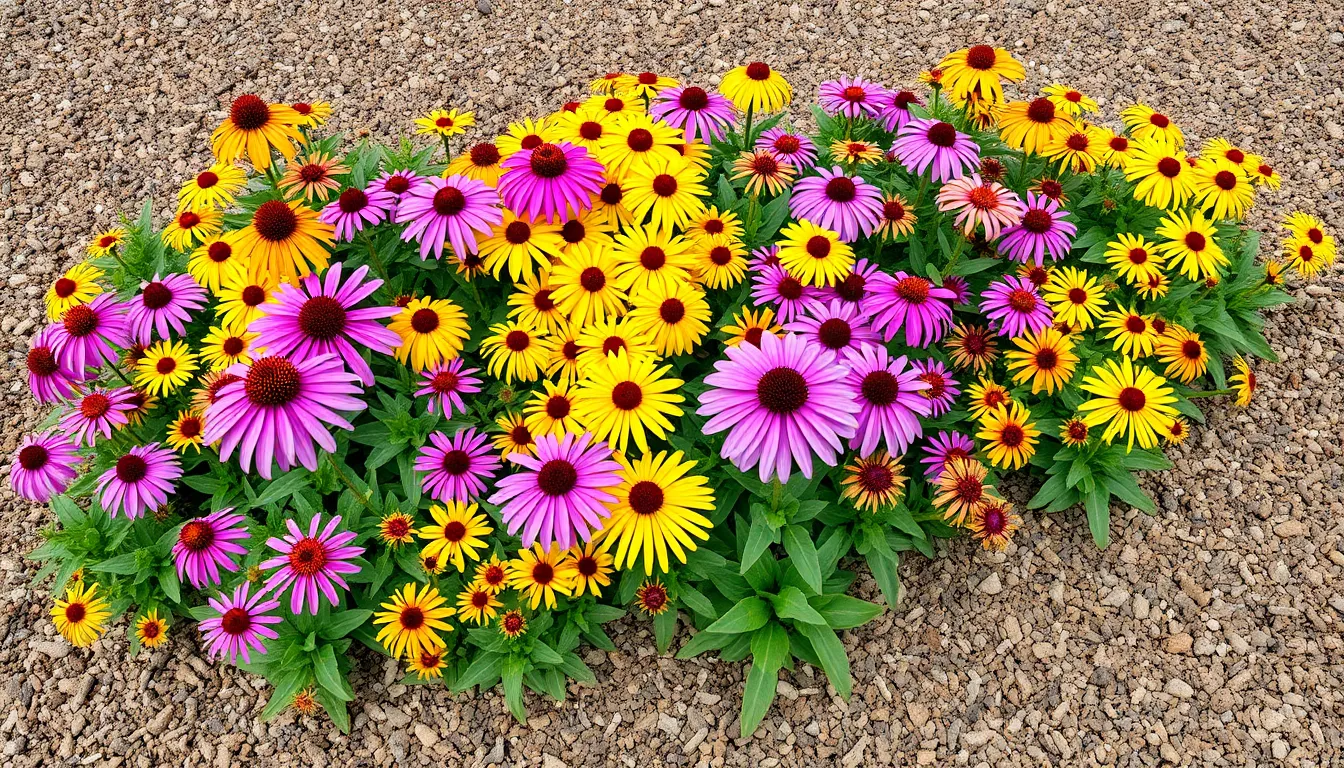
Creating stunning flower beds becomes effortless when we focus on perennial plants that return year after year. These resilient beauties eliminate the need for annual replanting while providing consistent color and structure to our garden spaces.
We’ll achieve the most success by selecting proven perennials like coneflowers, black-eyed Susans, and daylilies that require minimal maintenance once established. Layered planting creates visual depth when we position taller perennials toward the back and shorter varieties in front. Mixing different textures and foliage types adds dimension and interest throughout the growing season.
Choose Native Plants That Thrive in Your Climate
Native plants offer the ultimate low maintenance solution for our flower beds since they’ve evolved to flourish in local conditions. We’ll spend less time watering, fertilizing, and troubleshooting pest issues when we select plants that naturally belong in our region.
Matching plants to our exact climate conditions ensures long term success with minimal intervention. We should consider factors like average rainfall, temperature ranges, and sun exposure patterns when making our selections. Local extension offices and native plant societies provide valuable resources for identifying the best options for our area.
Plan Simple Color Schemes for Visual Impact
Strategic color planning transforms ordinary flower beds into eye catching displays that feel professionally designed. We can create cohesive looks using monochromatic schemes that feature different shades of a single color throughout the planting area.
Complementary colors from opposite sides of the color wheel produce vibrant contrasts that draw attention and create focal points. Pairing purple coneflowers with yellow black-eyed Susans exemplifies this effective approach. Neutral backgrounds using mulch or gravel help our chosen colors stand out while providing a clean, finished appearance to the entire flower bed.
Build Raised Garden Beds for Better Soil Control
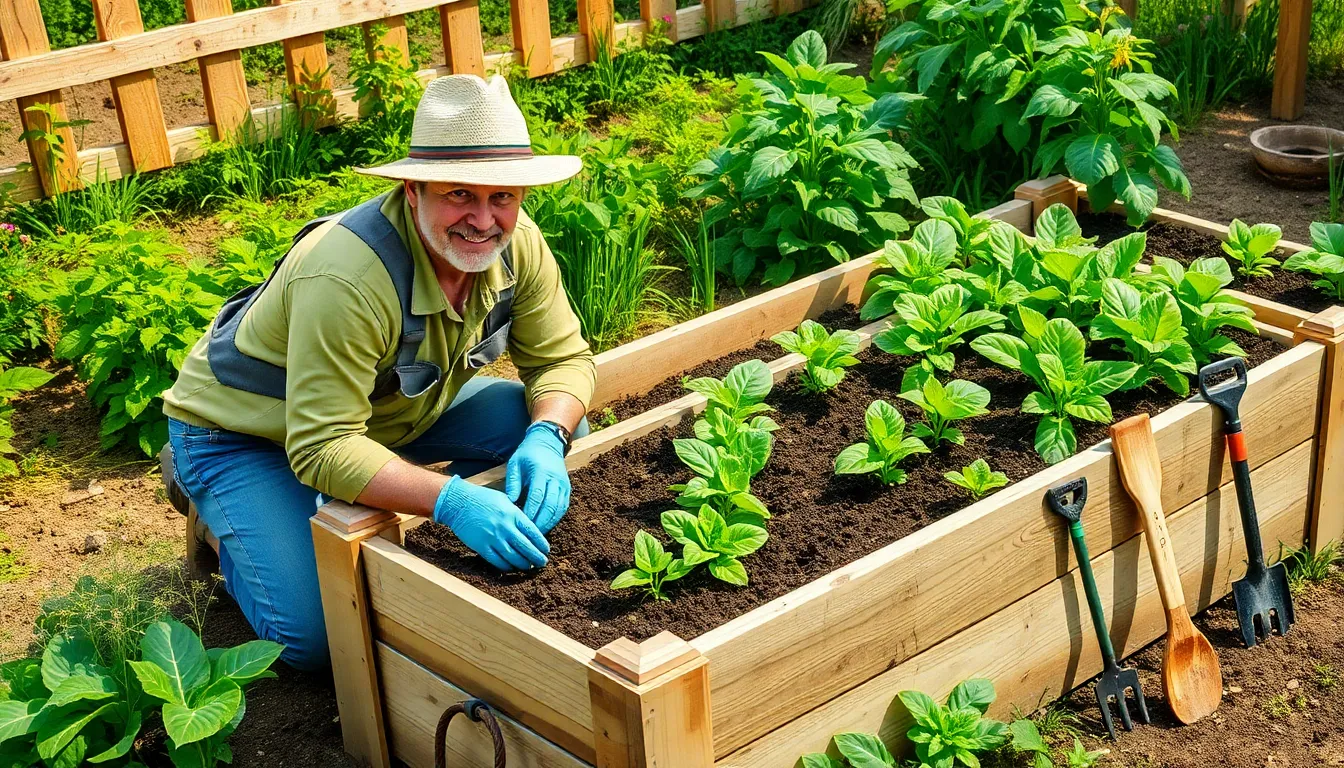
Creating raised garden beds gives us complete control over our growing environment while addressing poor soil conditions that many gardeners face.
Construct Simple Wooden or Metal Frames
Cedar wood frames offer the best durability for long term garden success, resisting rot and pest damage naturally. We recommend measuring board thickness accurately before marking placement points for framing angles to ensure proper alignment.
Drilling straight holes prevents splitting and creates secure connections between panels. Metal alternatives like steel frames provide even greater longevity, though they require different assembly techniques than wooden construction.
Budget conscious gardeners can build raised beds for under $100 using affordable materials and basic DIY methods. We start by clearing grass, weeds, and debris from our chosen site, then dig shallow trenches on sloped areas to create level foundations.
Checking elevation with a level tool ensures both sides of the bed maintain the same height throughout construction. Framing angles attach using screws, washers, and nuts to create stable panel connections that withstand weather and soil pressure.
Fill With Quality Soil Mix for Healthy Growth
Well draining soil mixes rich in organic matter promote healthy plant development and prevent waterlogged root systems. We select commercial potting mixes specifically formulated for raised bed applications rather than using heavy garden soil.
Applying mulch layers after planting retains moisture while suppressing weed growth naturally. Quality soil amendments like compost improve drainage and provide essential nutrients that plants need throughout growing seasons.
Adjusting bed dimensions according to available space allows us to customize growing areas for exact plant requirements. We fill beds gradually, watering lightly between soil additions to prevent settling and air pockets that damage root development.
Establish Low-Maintenance Ground Cover Areas
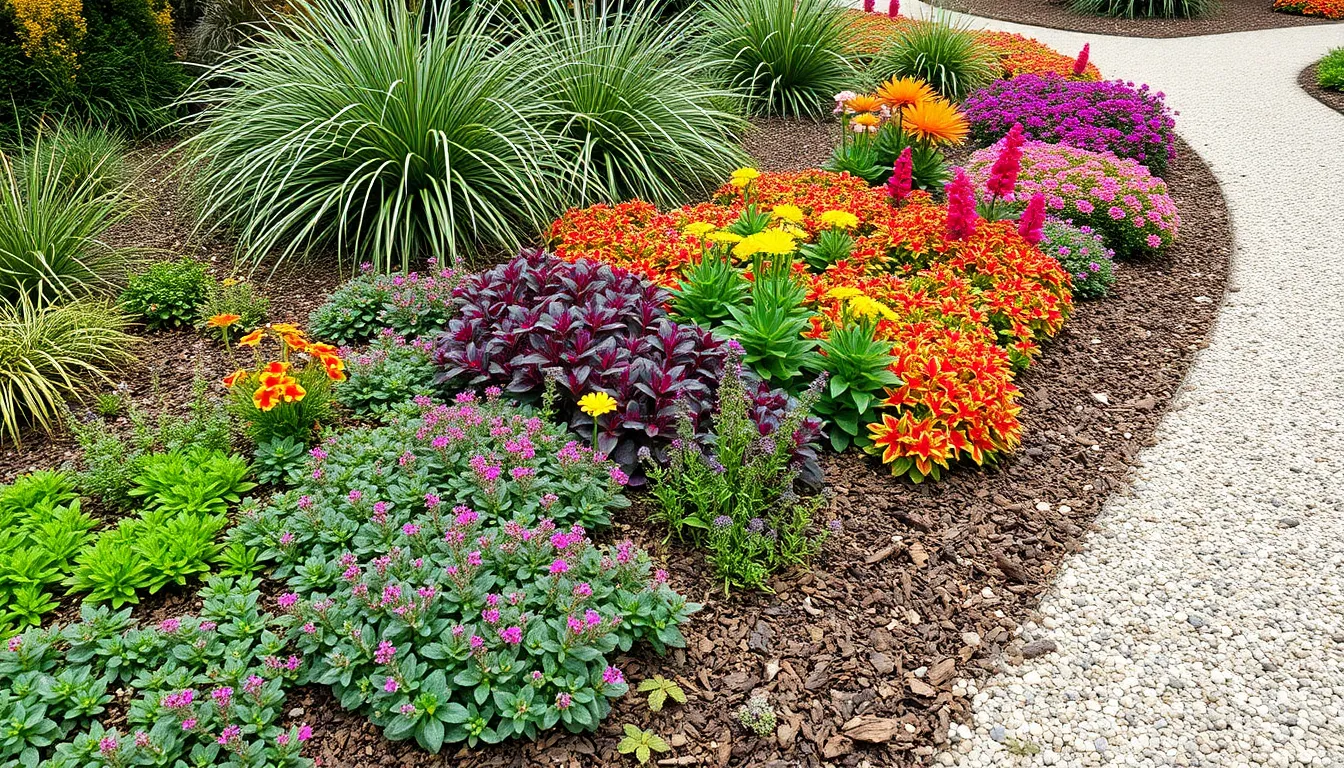
Creating beautiful garden spaces doesn’t require constant upkeep when we focus on strategic ground cover answers. These approaches significantly reduce our maintenance workload while improving garden health.
Replace Grass With Hardy Ground Cover Plants
Ground cover plants offer superior alternatives to traditional grass lawns by requiring minimal care and providing year-round beauty. Creeping thyme creates fragrant carpets that release pleasant aromas when stepped on, while sedum varieties produce colorful succulent foliage that thrives in dry conditions. Native clumping grasses naturally adapt to local climate conditions and spread efficiently to fill bare spaces.
These resilient plants suppress weeds naturally by forming dense mats that block sunlight from reaching unwanted seeds. Unlike conventional turfgrass, ground covers eliminate the need for regular mowing, frequent watering, and seasonal fertilizing. Many varieties withstand foot traffic remarkably well, making them practical choices for pathways and play areas.
Evergreen ground covers like pachysandra and vinca provide consistent color throughout winter months when grass typically goes dormant. Flowering options such as ajuga and wild ginger add seasonal interest with blooms that attract beneficial pollinators to our gardens.
Use Mulch to Suppress Weeds and Retain Moisture
Organic mulch serves as our garden’s protective barrier by blocking sunlight that weed seeds need for germination. Wood chips, shredded bark, and other organic materials create effective layers that prevent most weeds from establishing in our planting beds. This natural suppression method eliminates hours of manual weeding throughout growing seasons.
Moisture retention becomes effortless when we apply 2-3 inch layers of mulch around plants and trees. The organic matter acts like a sponge, holding water near root zones and reducing our watering frequency by up to 50%. Temperature regulation occurs naturally as mulch insulates soil from extreme heat and cold fluctuations.
Gravel and crushed stone provide permanent mulching answers for pathways and decorative areas where we want to eliminate grass maintenance entirely. These materials improve drainage while creating attractive, low-maintenance surfaces that require no mowing or seasonal care. Decomposing organic mulches gradually enrich soil structure, providing long-term benefits that support healthy plant growth with minimal intervention from us.
Install Simple Drip Irrigation for Effortless Watering
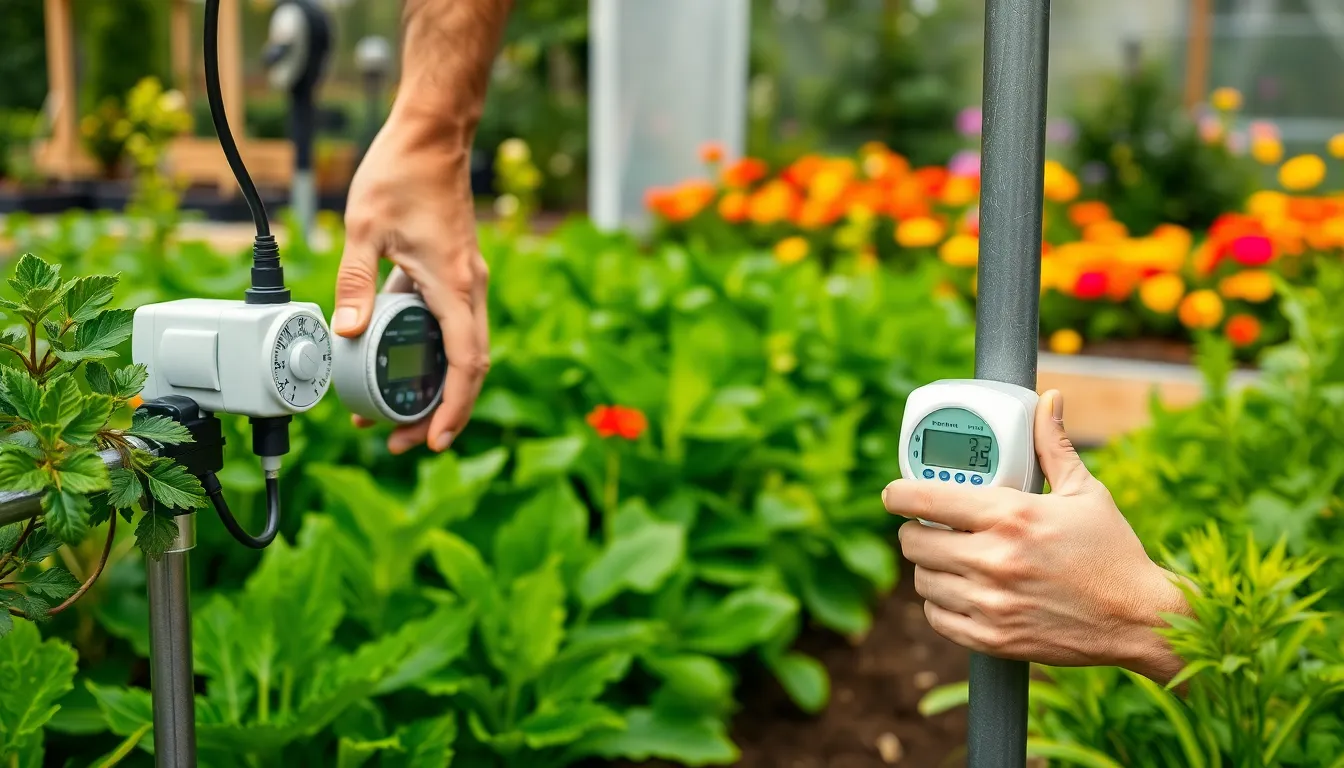
Installing a drip irrigation system revolutionizes your garden maintenance by delivering water directly to plant roots through tubes and emitters. We can connect drip lines to any faucet or hose bib using simple fittings that require no special tools or plumbing experience.
Vegetable gardens and flower beds benefit most from this targeted water delivery system because it minimizes waste while ensuring consistent moisture levels. Plants receive exactly the water they need without getting their foliage wet, which reduces disease risk and promotes healthier growth patterns.
Battery powered timers make drip irrigation completely automatic, allowing us to set watering schedules and forget about daily garden maintenance. Water reaches the root zone efficiently while we focus on other gardening tasks or enjoy our outdoor spaces.
Set Up Timer-Based Watering Systems
Manual timers offer the simplest entry point into automated watering by attaching directly to outdoor faucets and shutting off after preset durations. These affordable devices prevent overwatering incidents that commonly occur when we forget to turn off hoses manually.
Battery powered timers provide programmable schedules with multiple zone control and rain sensor capabilities that skip watering during natural rainfall. We can customize frequency, start times, and duration settings to match our garden’s exact water requirements throughout different seasons.
Smart timers connect to smartphones for remote control and automatically adjust watering based on local weather data. These advanced systems maximize water efficiency while giving us complete control over our irrigation schedules from anywhere.
| Timer Type | Key Features | Best For |
|---|---|---|
| Manual | Simple setup, automatic shutoff | Small gardens, basic needs |
| Battery-Powered | Programmable, multiple zones, rain sensors | Medium gardens, seasonal adjustments |
| Smart | Weather integration, remote control | Large gardens, tech-savvy gardeners |
Consistent soil moisture becomes achievable through timer automation, which supports healthy plant growth while reducing our daily garden maintenance responsibilities.
Choose Soaker Hoses for Even Water Distribution
Soaker hoses release water slowly along their entire length through porous walls that deliver moisture directly at soil surface level. We simply lay these hoses along garden rows and connect them to water sources for immediate installation without complicated fittings.
Garden beds and shrub plantings receive even water distribution that penetrates deeply into soil layers, promoting efficient root development without surface runoff or evaporation losses. Water seeps gradually into the ground rather than pooling on top or running away from target areas.
Timer connections automate soaker hose systems just like drip irrigation, creating hands off watering answers that maintain optimal soil moisture levels. We can combine soaker hoses with battery powered or smart timers to eliminate guesswork from our watering routines.
Root zones receive consistent hydration that supports plant health while conserving water resources through precise application methods. Deep soil penetration encourages stronger root systems that make plants more drought resistant over time.
Add Vertical Gardens to Maximize Growing Space
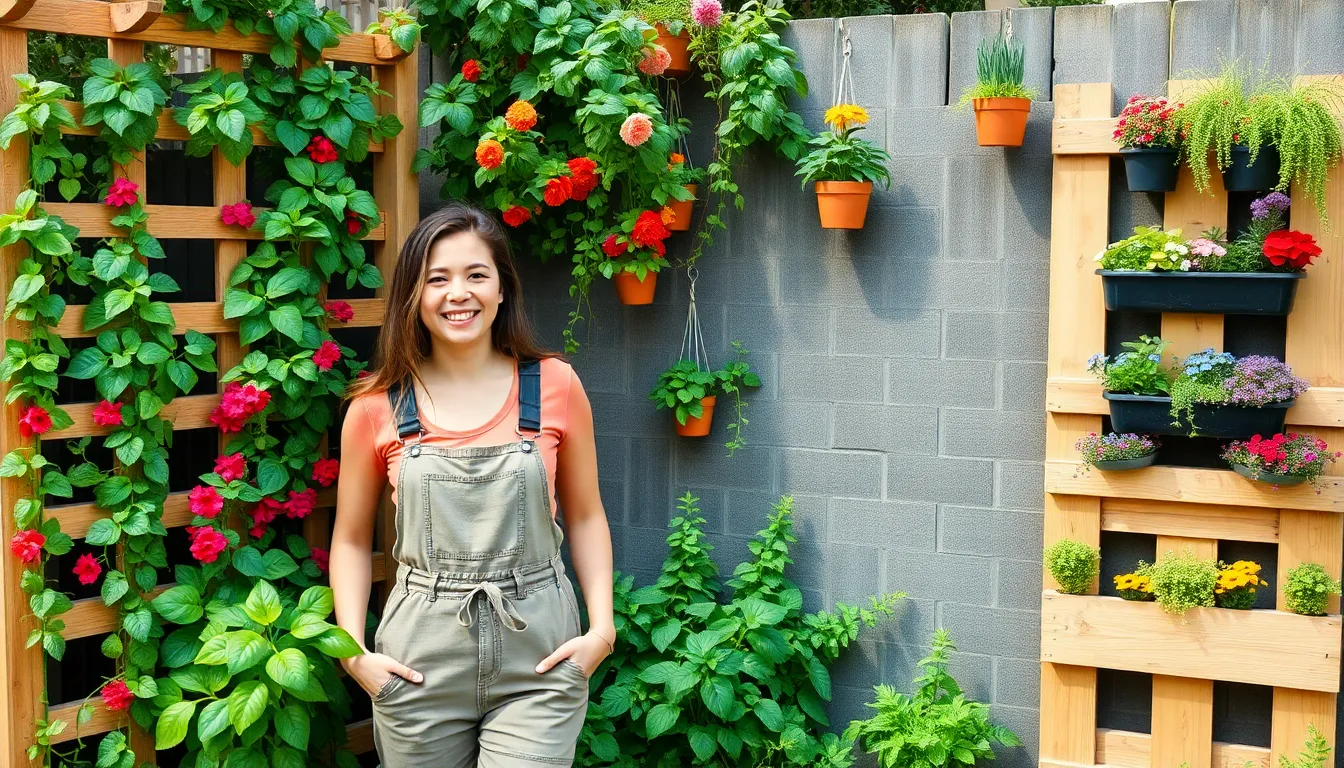
Vertical gardens offer an excellent solution for expanding our growing capacity without requiring additional ground space. We can transform walls, fences, and overhead areas into productive growing surfaces using simple DIY techniques.
Use Trellises and Wall-Mounted Planters
Trellises provide sturdy support structures for climbing plants while maximizing our vertical growing potential. We can construct these supports using wood, metal, or bamboo materials depending on our budget and aesthetic preferences. Building a basic wooden trellis requires minimal carpentry skills and creates an ideal framework for beans, peas, cucumbers, and flowering vines to climb naturally upward.
Wall-mounted planters transform unused wall surfaces into productive growing areas perfect for herbs and root vegetables. Mounting these containers on fences, balconies, or garden walls allows us to grow plants in previously unusable spaces. Installing planters at eye level makes harvesting and maintenance tasks much easier while improving air circulation around our plants.
Repurposed materials like wooden pallets and hanging baskets offer budget-friendly alternatives to store-bought vertical gardening systems. Converting old pallets into vertical planters requires only basic tools and creates multiple growing pockets for smaller plants. These DIY answers work especially well for apartment dwellers and renters who need portable gardening options.
Grow Climbing Plants and Hanging Vegetables
Climbing crops naturally increase our garden’s productivity by growing upward instead of spreading outward across valuable ground space. Tomatoes, pole beans, and squash thrive when trained to grow vertically using trellises or stakes for support. Training these plants upward also improves sunlight exposure and makes harvesting much more convenient.
Cherry tomatoes and strawberries work exceptionally well in upside-down hanging containers suspended from pergolas or porch ceilings. Growing vegetables in hanging planters utilizes overhead space that would otherwise remain unused while creating an attractive garden display. Suspended containers also help protect crops from ground-dwelling pests and soil-borne diseases.
Stakes and cages provide additional support options for heavy fruiting plants that need extra stability as they mature. We recommend installing these supports early in the growing season before plants become too large to handle easily. Combining different vertical elements creates a layered garden design that maximizes both growing space and visual appeal throughout our outdoor areas.
Incorporate Easy-Care Succulents and Cacti
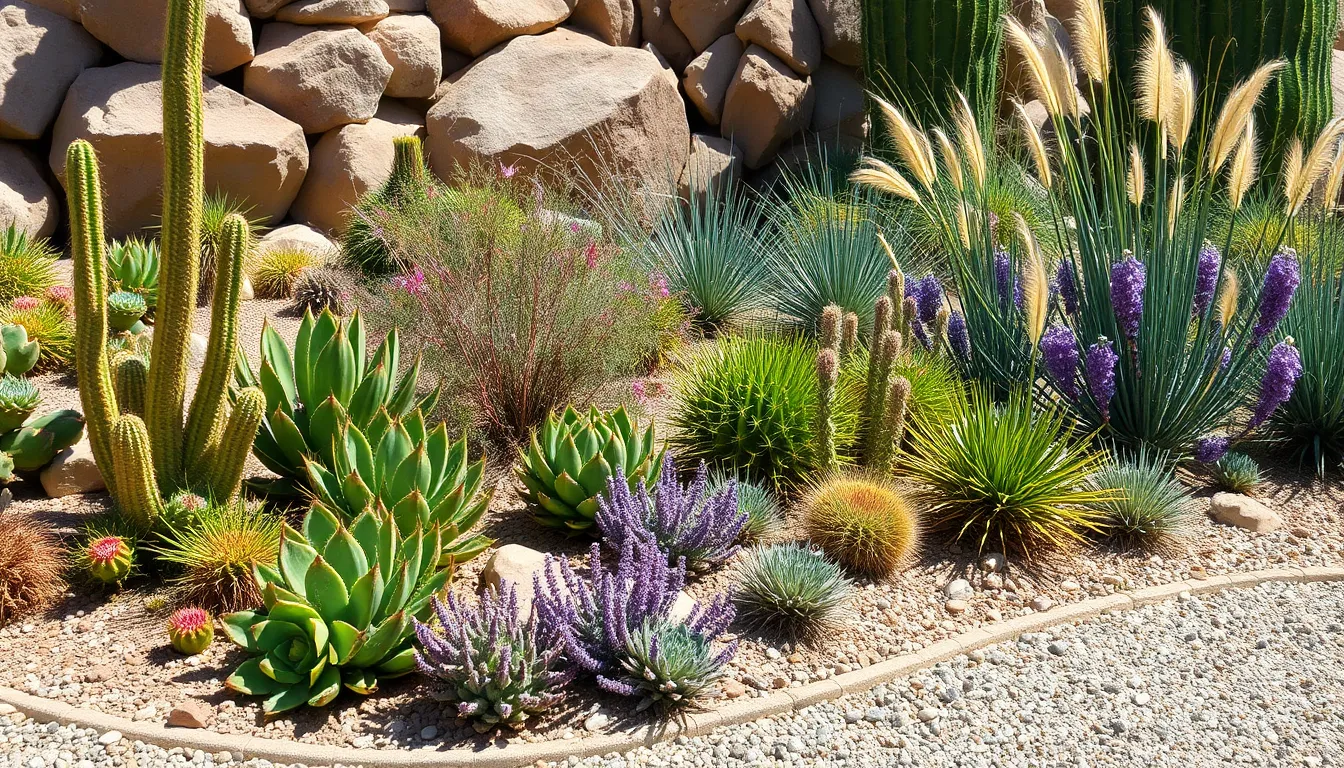
Succulents and cacti represent perfect answers for gardeners seeking beautiful plants with minimal maintenance requirements. These remarkable plants store water in their leaves or stems, making them naturally drought resistant and ideal for hot, dry climates where traditional plants struggle.
Create Desert-Style Garden Sections
Designating exact areas of your garden to mimic desert landscapes transforms challenging spaces into stunning focal points. We recommend grouping succulents and cacti together to create cohesive desert themed sections that require minimal upkeep compared to traditional garden beds.
Gravel, sand, or decorative rocks serve as excellent mulching materials that enhance the desert aesthetic while providing essential drainage for these water storing plants. Hardy desert plants like barrel cacti, prickly pear, and various agave species thrive in full sun conditions and demand very little water once established.
Desert style gardens naturally require less maintenance than conventional flower beds, making them particularly well suited for arid regions and busy gardeners who want maximum visual impact with minimal effort.
Choose Drought-Tolerant Varieties for Hot Climates
Selecting plants that have evolved to survive with minimal water ensures your garden remains vibrant even during dry spells. Lavender, agave, yucca, and ornamental grasses like fountain grass and blue fescue excel in hot climates while adding diverse textures and colors to your industry.
These resilient varieties reduce your overall watering needs significantly and demonstrate remarkable tolerance to heat and intense sun exposure. Mulching around drought tolerant plants helps retain precious soil moisture and naturally suppresses weed growth, further reducing your maintenance responsibilities.
Varied shapes, colors, and sizes among these hardy plants create visual interest and texture throughout your garden with minimal effort on your part. Purple flowering lavender pairs beautifully with silvery blue agave leaves, while ornamental grasses provide movement and softness to balance the structured forms of cacti and succulents.
Plant Fast-Growing Vegetables for Quick Harvests

We can achieve satisfying garden results in just weeks by selecting vegetables known for their rapid growth cycles. Fast growing vegetables provide quick harvests that keep us motivated while building our gardening confidence.
Start With Lettuce, Radishes, and Green Beans
Lettuce varieties offer our first taste of success with harvest times between 45 to 50 days for most types. We love how lettuce thrives in cooler temperatures and allows us to practice succession planting for continuous harvests throughout the growing season. Buttercrunch, romaine, and leaf lettuce varieties work exceptionally well for beginners seeking reliable results.
Radishes deliver the fastest gratification in our vegetable garden, reaching maturity in just 20 to 30 days from seed. These peppery additions to our salads require minimal space and can be interplanted between slower growing vegetables like tomatoes or peppers. Cherry Belle and French Breakfast radishes provide excellent flavor while teaching us proper spacing techniques.
Green beans require slightly more patience at approximately 50 days to harvest, but they reward our efforts with abundant yields from compact plants. Bush varieties eliminate the need for trellising systems, making them perfect for our first vegetable gardening attempts. Provider and Contender varieties produce consistently in various weather conditions.
Use Square Foot Gardening Methods
Square foot gardening transforms our approach by dividing raised beds into organized 1 foot by 1 foot sections that maximize growing space while minimizing waste. This systematic method allows us to plant different vegetables in each square according to their mature size requirements.
Planting density increases dramatically when we follow square foot guidelines, fitting 16 radishes, 9 lettuce plants, or 4 bean plants per individual square. We achieve higher yields per square foot compared to traditional row gardening while reducing the amount of soil preparation needed.
Efficient watering becomes simpler with organized plant placement that creates clear pathways between growing sections. Grid systems help us target water delivery directly to plant roots while keeping walkways dry for easier garden maintenance and harvesting activities.
Design Simple Pathways With Basic Materials
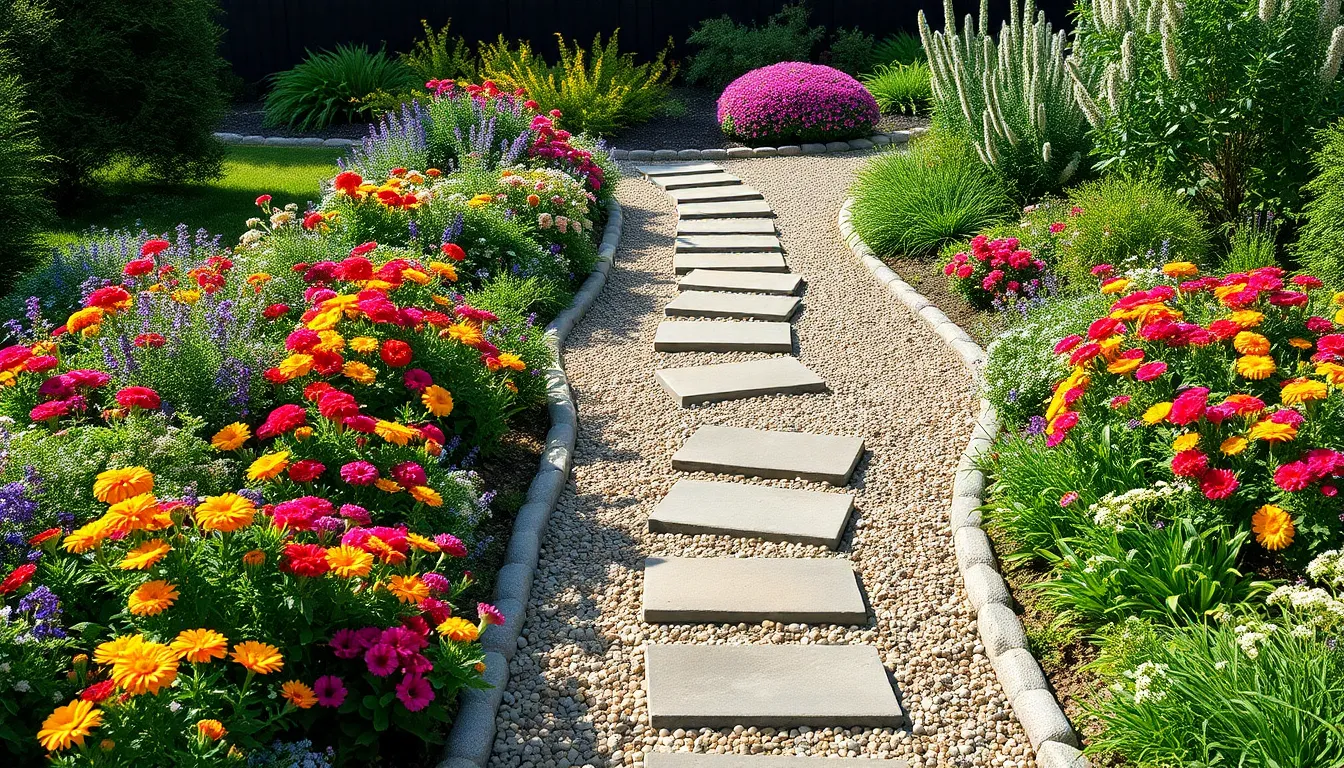
Garden pathways connect different areas of our outdoor space while adding structure and visual appeal to our industry design.
Use Gravel, Stepping Stones, or Mulch
Gravel pathways offer the most affordable and drainage-friendly option for garden walkways. We can install these paths quickly by digging a shallow trench and laying weed-suppressing material as our foundation. Installing gravel requires minimal tools since we simply need to add a base layer of crushed aggregate followed by decorative gravel layers for the surface.
Stepping stones work perfectly as standalone features or combined with gravel and mulch for enhanced visual interest. We can space these stones evenly through garden beds to create natural walking patterns that guide visitors through our industry. Combining stepping stones with surrounding materials like river rock or wood chips creates cohesive pathways that blend seamlessly with existing garden elements.
Mulch pathways provide an eco-friendly solution that requires virtually no installation effort beyond spreading the material. We should plan for annual topping up since organic mulch naturally decomposes and needs refreshing each season. Wood chips and bark mulch create soft walking surfaces that complement plantings while providing excellent weed suppression between garden areas.
| Material | Installation Difficulty | Annual Maintenance | Drainage Quality |
|---|---|---|---|
| Gravel | Easy | Low | Excellent |
| Stepping Stones | Moderate | Very Low | Good |
| Mulch | Very Easy | Moderate | Fair |
Create Defined Walking Areas Through Your Garden
Edging materials contain loose pathway materials like gravel or mulch while creating clear boundaries between walkways and planting areas. We can use flexible metal edging, stone borders, or recycled materials to establish these defined edges without important expense. Installing edging prevents pathway materials from spreading into garden beds and maintains clean lines throughout our industry.
Strategic plant placement along pathway edges enhances visual appeal while integrating walkways with surrounding garden elements. We should select low-growing perennials or ornamental grasses that won’t obstruct the path but provide seasonal interest and natural borders. Plants like lavender, ornamental grasses, and compact hostas create living edges that soften hard pathway materials.
Pathway width planning ensures comfortable walking while maximizing garden space for planting areas. We typically need 3-4 feet for main pathways and 18-24 inches for secondary garden paths that access planting beds. Winding paths through garden beds create more interesting routes than straight lines while allowing us to showcase different plant groupings and seasonal displays throughout our industry.
Conclusion
Creating our dream garden doesn’t have to be overwhelming or expensive. We’ve shown you that with simple container gardens vertical growing answers and strategic plant choices anyone can transform their outdoor space into a thriving sanctuary.
The key lies in starting small and building confidence with each success. Whether we’re growing herbs on windowsills or designing raised beds these approaches work for every skill level and budget.
Remember that gardening should bring joy not stress. By choosing low-maintenance plants implementing efficient watering systems and focusing on proven techniques we can enjoy beautiful results without constant upkeep. Our outdoor spaces are waiting to be transformed—and now we have all the tools to make it happen.
Frequently Asked Questions
What is the best way to start gardening in small spaces?
Container gardening is the ideal solution for small spaces like balconies or patios. Choose appropriately sized containers with proper drainage, and start with low-maintenance plants such as herbs, succulents, or annual flowers. Position containers strategically to maximize sunlight exposure and ensure your plants thrive even in limited space.
Which plants are easiest for beginner gardeners?
Start with herbs like basil, mint, thyme, and cilantro, which are forgiving and useful. Succulents require minimal water and care, while native plants naturally thrive in your local climate. Annual flowers and easy vegetables like lettuce and radishes also provide quick, rewarding results for new gardeners.
How do I create a low-maintenance garden?
Choose perennial plants that return yearly, such as coneflowers and black-eyed Susans. Use ground cover plants like creeping thyme instead of grass, apply organic mulch to suppress weeds, and install drip irrigation systems for efficient watering. Select native plants that require less water and care in your climate.
What materials work best for container gardening?
Cedar, steel, and terra cotta containers are excellent choices. Cedar offers natural durability, steel provides modern aesthetics, and terra cotta allows good air circulation. Ensure all containers have drainage holes to prevent root rot and choose sizes appropriate for your plants’ mature growth.
How can I maximize space in a small garden?
Use vertical gardening with trellises and wall-mounted planters for climbing plants. Try square foot gardening methods to organize plantings efficiently. Window boxes and small raised beds help maximize growing area, while hanging planters utilize overhead space for trailing vegetables and flowers.
What are the benefits of raised garden beds?
Raised beds provide better soil control, improved drainage, and easier maintenance. They’re perfect for areas with poor soil conditions and can be customized to any size. Fill them with quality soil mixes rich in organic matter to promote healthy plant growth and reduce weeding requirements.
How do I set up an efficient watering system?
Install drip irrigation systems that deliver water directly to roots, minimizing waste. Use battery-powered or smart timers to automate watering schedules. Soaker hoses provide even water distribution and promote deep soil penetration, while conserving water resources compared to traditional sprinkler systems.
What plants grow fastest for quick results?
Lettuce, radishes, and green beans provide harvests within weeks of planting. These fast-growing vegetables boost confidence and provide immediate satisfaction. Herbs like basil and cilantro also grow quickly and can be harvested continuously throughout the growing season for fresh cooking ingredients.

